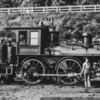I went out with my friend Brian Vangor, historian and videographer, on November 20th to look for remnants of the New York, Westchester & Boston. The railroad ran from 1912 to 1937. One common thread in the construction of the stations is that they were overbuilt, built in a substantial way that in some cases allowed the stations to survive long past the railroad had disappeared. Considering the railroad stopped running so many years ago, it is still remarkable that there are significant remnants of the railroad that exist in 2016.
Tom
Wykagyl Station (North Ave., New Rochelle, NY)...The building is now retail space (center of the picture).
The arches over the windows (or in other cases, arched windows) that were so common on NYW&B stations are clearly noticeable in back of the station where the current day shopping center parking lot exists.
Heathcote Station (Scarsdale, NY)...For many years the station was used by the local volunteer ambulance corps, until they found a new location nearby. After that, a realtor took over the building, but needed to restore the building to certain historic standards that the village required.
Original railings still exist next to the station.
Ridgeway Station...(White Plains, NY,)
The station is long gone but some concrete remnants of the platform and station area still exist as does lots of fine looking ballast. The once overgrown right-of-way was turned into a trail because of a little girl from the neighborhood who pushed for such an outcome.
Concrete transmission tower post at Ridgeway
Street signs near Ridgeway Station.
Larchmont Gardens Station (Larchmont, NY)...now a girl scout cabin. A signal tower/transmission tower can be seen above the building, illustrating how close the New Haven Railroad's main line was and still is today.
The area directly above the door has some raised brick pieces and some metal posts, possibly indicating where the station sign would have hung.
Mamaroneck Station (Mamaroneck, NY)...one of my own personal favorites. Here we see the front of the station on a crisp fall day. This beautiful red brick station, now houses a restaurant. A parking lot behind the building and between the New Haven main line marks the location of the NYW&B's trackage. Edited Dec. 16, 2016-- I should have been a little more clear that this station was a New Haven station ...but the NYW&B shared it.
Port Chester Station (Port Chester, NY)...The building was a former Pontiac car dealership for many years, now serving a different clientele...as a church. The tower was not original to the station.
Tom








